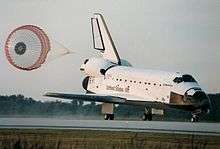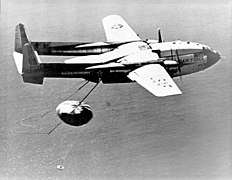Soft landing (aeronautics)
A soft landing is any type of aircraft, rocket or spacecraft landing that does not result in significant damage to or destruction of the vehicle or its payload, as opposed to a hard landing. The average vertical speed in a soft landing should be about 2 meters (6.6 ft) per second or less.

.jpg)
A SpaceX Crew Dragon capsule splashes down

A Corona Spy Sattelite film capsule is caught by a C-119J
A soft landing can be achieved by
- Parachute—often this is into water.
- Vertical rocket power using retrorockets, often referred to as VTVL (vertical landing referred to as VTOL, is usually for aircraft landing in a level attitude, rather than rockets — first achieved on a suborbital trajectory by New Shepard and a short-while later on an orbital trajectory by the Falcon 9.
- Horizontal landing, most aircraft and some spacecraft, such as the Space Shuttle, land this way.
- Being caught, as attempted with Genesis (spacecraft) and followed by some other form of landing.
This article is issued from Wikipedia. The text is licensed under Creative Commons - Attribution - Sharealike. Additional terms may apply for the media files.
